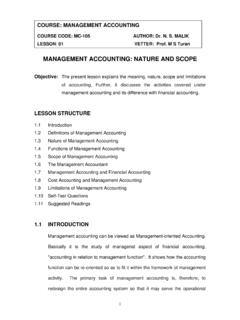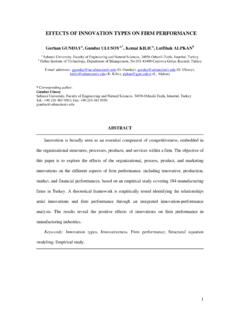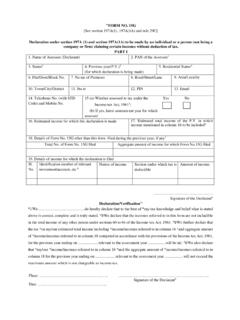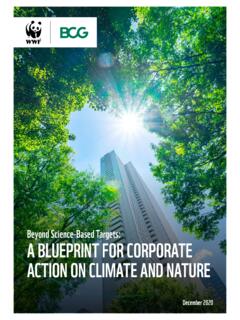Transcription of COLLABORATING DURING CORONAVIRUS: THE IMPACT OF …
1 NBER WORKING PAPER SERIESCOLLABORATING DURING CORONAVIRUS: THE IMPACT OF COVID-19 ON THE nature OF WORKEvan DeFilippisStephen Michael ImpinkMadison SingellJeffrey T. PolzerRaffaella SadunWorking Paper 27612 BUREAU OF ECONOMIC RESEARCH1050 Massachusetts AvenueCambridge, MA 02138 July 2020 The views expressed herein are those of the authors and do not necessarily reflect the views of the National Bureau of Economic working papers are circulated for discussion and comment purposes. They have not been peer-reviewed or been subject to the review by the NBER Board of Directors that accompanies official NBER publications. 2020 by Evan DeFilippis, Stephen Michael Impink, Madison Singell, Jeffrey T. Polzer, and Raffaella Sadun. All rights reserved. Short sections of text, not to exceed two paragraphs, may be quoted without explicit permission provided that full credit, including notice, is given to the DURING Coronavirus: The IMPACT of COVID-19 on the nature of WorkEvan DeFilippis, Stephen Michael Impink, Madison Singell, Jeffrey T.
2 Polzer, and RaffaellaSadunNBER Working Paper No. 27612 July 2020 JEL No. L2,L23,M0 ABSTRACTWe explore the IMPACT of COVID-19 on employee's digital communication patterns through an event study of lockdowns in 16 large metropolitan areas in North America, Europe and the Middle East. Using de- identified, aggregated meeting and email meta-data from 3,143,270 users, we find, compared to pre- pandemic levels, increases in the number of meetings per person (+ percent) and the number of attendees per meeting (+ percent), but decreases in the average length of meetings ( percent). Collectively, the net effect is that people spent less time in meetings per day ( percent) in the post- lockdown period. We also find significant and durable increases in length of the average workday (+ percent, or + minutes), along with short-term increases in email activity.
3 These findings provide insight from a novel dataset into how the nature of work has changed for a large sample of knowledge workers. We discuss these changes in light of the ongoing challenges faced by organizations and workers struggling to adapt and perform in the face of a global DeFilippis Harvard Business School Soldiers FieldBoston, MA 02163 Michael Impink 44 West 4th Street New York, NY 10012 Singell Harvard Business School Soldiers FieldBoston, MA 02163 T. Polzer Harvard Business School Soldiers FieldBoston, MA 02163 Sadun Harvard Business School Morgan Hall 233 Soldiers FieldBoston, MA 02163and DeFilippis et al. (2020) | 2 Introduction The COVID-19 global pandemic has disrupted the way organizations function, just as it has disrupted life more generally. As the number of infections increased, governments across the globe closed their borders and shut down physical work sites in an attempt to reduce the spread of infection caused by the virus.
4 As of April 7, 2020, 95 percent of Americans were required to shelter-in-place within their homes, similar to the citizens of many other countries. Organizations have responded by altering their work arrangements to accommodate these new realities, including a rapid shift to working from home for large segments of knowledge workers. Given the large scale economic and social upheaval wrought by COVID-19, this abrupt transition to remote work occurs at a time when organizational coordination, decision-making processes, and productivity have never been more consequential. The global policy response to COVID-19 represents an unprecedented natural experiment in which, for the first time, many organizations across the world find themselves with a fully physically dispersed workforce. Moreover, employees had to quickly shift to relying on digital communication technologies to perform their job regardless of how conducive their home environment or task requirements were to such arrangements.
5 While most knowledge workers had engaged in some form of remote work prior to the pandemic, they typically did so with the support of colleagues physically co-located in a centralized office (Raghuram et al., 2019). For all the anecdotes and speculation about working from home DURING the pandemic, there is still little systematic evidence about how employees have changed their day-to-day work activities as a consequence of these unexpected shocks. In particular, how have employees changed their patterns of digital communication -- , meetings and emails -- to compensate for the lack of face-to-face conversation that typically occurs in a physical workplace? Have various dimensions of meeting and email activity, such as their frequency or scope, changed as employees and organizations adapt to a new working environment? Generalizing from past research on work from home arrangements is challenging, given that most remote work prior to COVID-19 was voluntary, less widespread, and performed under less dramatic circumstances (Bloom et al.)
6 , 2015; Choudhury et al., 2019). This paper provides the first large scale analysis of how digital communication patterns have changed in the early stages of the pandemic. To study this question, we acquired de-identified, aggregated meta-data from an information technology services provider that licenses digital communications solutions to organizations around the world. We use aggregated digital meta-data on emails and meetings for 3,143,270 users across 21,478 de-identified firms in 16 large metropolitan areas, aggregated by the provider to the level of Metropolitan Statistical Area (MSA) and day, across all available firms (see Appendix, Figure S1 and S2). The meta-data provides information on both email and meeting frequency, as well as other salient aspects of digital communications and interactions such as meeting size and duration, the number of email recipients, and the time emails are sent, among other dimensions (see Appendix, Table S1).
7 We selected 16 Metropolitan Statistical Areas (MSAs) that have experienced government-mandated lockdowns. These lockdowns established a clear breakpoint after which we could infer that people were working from home. The earliest lockdown in our data occurred on March 8, 2020, in Milan, Italy, and the latest lockdown occurred on March 25, 2020, in Washington, DC (see Table 1 for more information). We report data from a window starting eight weeks prior to the lockdown and ending eight weeks after the lockdown in each MSA to explore how the behavior of workers changed. DeFilippis et al. (2020) | 3 In analyzing digital communication patterns across a large number of firms and regions, we build upon an emerging literature that uses communication meta-data to measure otherwise hidden networks and patterns of communication (Impink et al.)
8 , 2020; Polzer et al., 2018). Other studies have used similar meta-data to reveal the importance of meeting and email patterns for a variety of organizational outcomes (Kleinbaum et al., 2013; Srivastava et al., 2018). Table 1: Lockdown Dates Dates MSA 100 Cases Lockdown Milan 20-Feb 8-Mar Rome 20-Feb 10-Mar Osla 4-Mar 12-Mar Madrid 28-Feb 14-Mar Zurich 2-Mar 16-Mar Geneva 2-Mar 16-Mar San Jose 10-Mar 16-Mar Paris 10-Feb 17-Mar San Francisco 10-Mar 17-Mar Brussels 5-Mar 18-Mar Tel Aviv 6-Mar 19-Mar Chicago 27-Feb 21-Mar New York City 10-Mar 21-Mar London 17-Feb 24-Mar Washington, 14-Mar 25-Mar Results Our primary objects of investigation are average measures of digital communication patterns built from collaboration metadata, aggregated at the MSA-day level. We use a regression-based event study to examine how these measures vary before and after government-mandated For the purpose of our study, we grouped digital communication measures into two categories of interest: meeting and email activity.
9 The total amount of time employees in any firm collectively spend in meetings is a function of three parameters that can vary independently: average meeting duration, average meeting size, and total number of meetings. We find an increase in the total count of meetings per person per day (+ [CI: + to + ], + meetings per person per day) 2, an increase in the average number of attendees per meeting (+ [+ to + ], + attendees per meeting), and a decrease in the average duration of meetings ( [ to ], minutes per meeting). That is, organizations in the post-lockdown period appeared to have more frequent meetings with more attendees, and shorter meetings, compared to the prior period. The net effect of these changes was to significantly reduce the total number of hours employees spent in meetings DURING the post-lockdown period ( [ to ], minutes per person per day).
10 All of these results are significant at the p < .001 level. DeFilippis et al. (2020) | 4 For daily email activity, we find that several email measures increased in the post-lockdown period. Specifically, we find significant increases in the average number of emails sent and received among people from the same organization, which we refer to as internal emails (+ [+ to ], + emails per person per day). We also find that there was a significant increase in the average number of recipients included on emails sent in the post-lockdown period (+ [+ to + ], + recipients per email sent). However, external emails and distinct emails sent (unique emails counted only once, regardless of the number of internal or external recipients) did not significantly change in the post-lockdown period. Using the span of time defined by the first and last email sent or meeting attended in a 24-hour period, we also find the average workday span increased by + minutes (+ [+ to + ]), partly due to increases in emails sent after business hours (+ [+ to ], + emails per person per day).


















